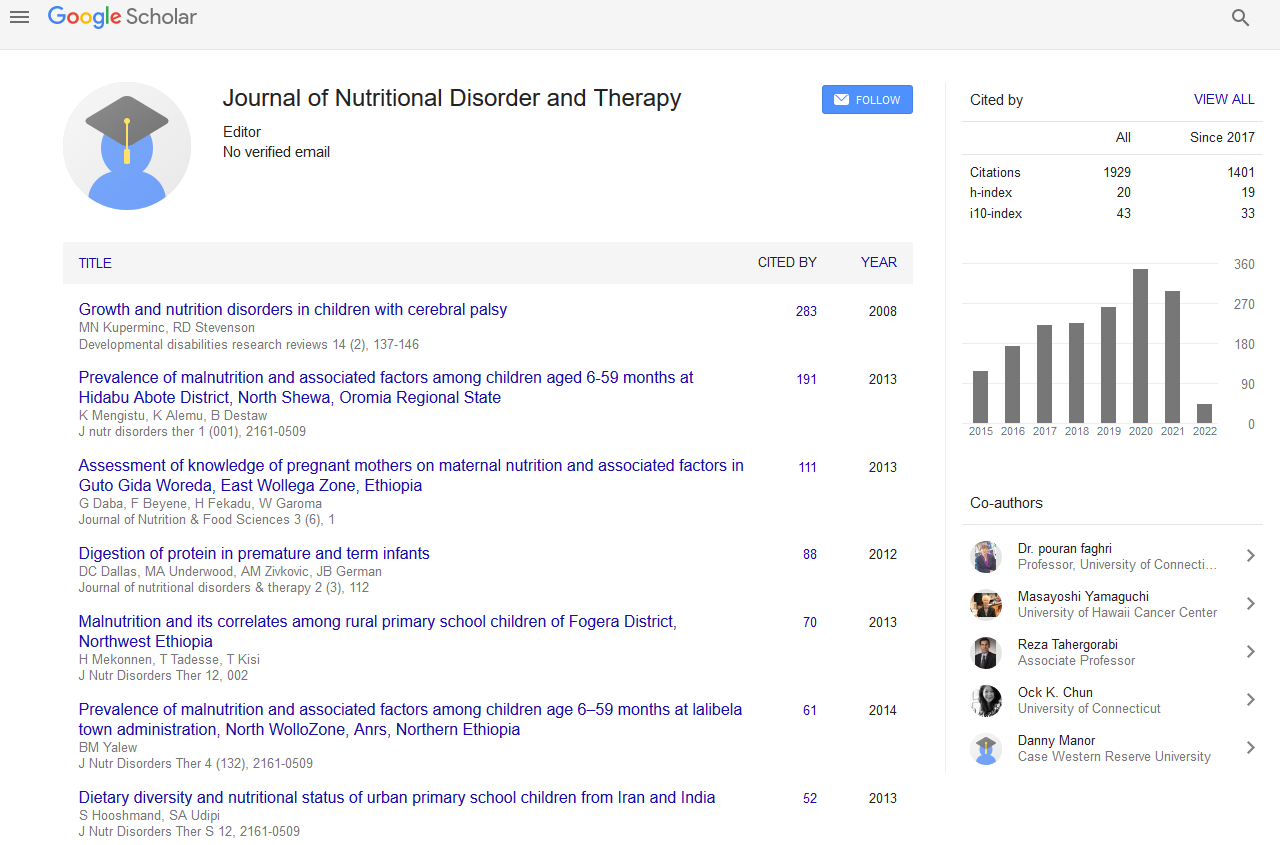Indexed In
- Open J Gate
- Genamics JournalSeek
- Academic Keys
- JournalTOCs
- Ulrich's Periodicals Directory
- RefSeek
- Hamdard University
- EBSCO A-Z
- OCLC- WorldCat
- Publons
- Geneva Foundation for Medical Education and Research
- Euro Pub
Useful Links
Share This Page
Journal Flyer

Open Access Journals
- Agri and Aquaculture
- Biochemistry
- Bioinformatics & Systems Biology
- Business & Management
- Chemistry
- Clinical Sciences
- Engineering
- Food & Nutrition
- General Science
- Genetics & Molecular Biology
- Immunology & Microbiology
- Medical Sciences
- Neuroscience & Psychology
- Nursing & Health Care
- Pharmaceutical Sciences
Alpha lipoic acid alleviates hyperlipidemia, and inflammation of visceral adipose tissue in high-fat-diet plus STZ-treated rat model
JOINT EVENT: 13th International Congress on Advances in Natural Medicines Nutraceuticals & Neurocognition & 14th International Conference on Clinical Nutrition
July 27-29, 2017 Rome, Italy
Meng-Shiuan Tu, Pei-Chin Wu, Rong-Shiuan Tu, Shih-Shiang Lin, Wen-Chang Chang, Yu-Wen Ting, James Swi-Bea Wu and Szu-Chuan Shen
National Taiwan Normal University, Taiwan
National Taiwan University, Taiwan
Posters & Accepted Abstracts: J Nutr Disorders Ther
Abstract:
Statement of the Problem: Hyperlipidemia is a symptom commonly occurring in type 2 diabetes mellitus (T2DM). Studies suggest that individuals with both T2DM and hyperlipidemia may increase the risk of cardiovascular disease (CVD)-related complications, such as coronary artery disease. The dysfunction of visceral adipose tissue (VAT) is considered to be associated with insulin resistance and subsequently results in the lipid metabolism abnormality in T2DM. Evidence indicates that inflammatory related markers such as tumor necrosis factor-alpha (TNF-a), interleukin 6 (IL-6) and nuclear factor kappa-β are associated with the serum lipid level. Alpha lipoic acid (ALA) is an endogenous cofactor located in mitochondria. Previous studies reported that ALA has therapy potential on hypoglycemia in diabetic rats. This study further investigates the effect of ALA on hyperlipidemia in high-fat-diet plus STZ-induced hyperinsulinemic rats. Methodology & Theoretical Orientation: Male Wistar rats were fed high fat diet (HFD, 60% fat of calorie) for 4 weeks followed by single intra-peritoneal injection of Streptozotocin (STZ, 30mg kg-1) and then served HFD continuously for 8 weeks to induce hyperinsulinemia. These HFD-STZ-induced hyperinsulinemic rats were orally administered with ALA once a day at a dosage of 200 mg kg-1 for 13 weeks. After rats were sacrificed, the serum lipid profiles were measured, the VAT (epididymal and perirenal adipose tissues) was picked up and weighed, and the pro-inflammation related cytokines of VAT were analyzed. Findings: Our results showed that HFD plus STZ treatment results in hyperinsulinemia (1.53 μg mL-1) in rats. The administration of ALA significantly reduced the levels of fasting serum insulin, total cholesterol (TC), low density lipoprotein (LDL), triglyceride (TG) and free fatty acid (FFA) by 55%, 39%, 73%, 68% and 53%, respectively, whereas significantly increased high density lipoprotein (HDL) level by 1.54 fold in hyperinsulinemic rats (p<0.05), suggesting the reduction on the risk of CVD-related complications. The relative VAT weights were significantly decreased by 40% (p<0.05) in ALA treated hyperinsulinemic rats (p<0.05), indicating the suppression of lipid accumulation. Moreover, ALA also significantly decreased the levels of pro-inflammatory cytokines such as IL-6, TNF-a in serum and IL-1β in VAT of hyperinsulinemic rats (p<0.05). Conclusion & Significance: In conclusion, the present study demonstrates that ALA may have benefits on preventing the progression of hyperlipidemia via ameliorating blood lipid profiles and inflammation of VAT in HFD-STZ-induced hyperinsulinemic rats.


